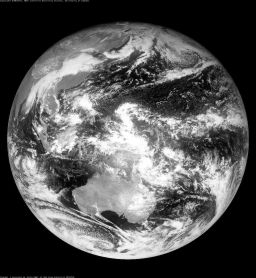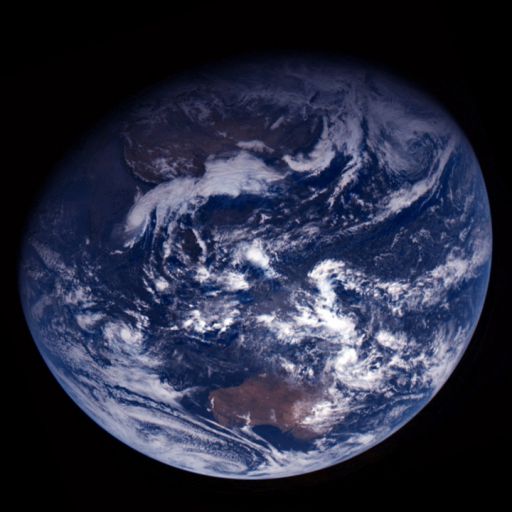Emily Lakdawalla • Nov 30, 2007
Flipping Earth
Amazingly, only one reader has emailed me to point out a problem with this image, released by ESA on November 20. I didn't notice the problem either. Look carefully.
![Rosetta Looks Back at Earth [DEPRECATED]](http://planetary.s3.amazonaws.com/image/OsirisEarthColor_20071511_H_med.jpg)
ESA ©2005 MPS for OSIRIS Team MPS / UPD / LAM / IAA / RSSD / INTA / UPM / DASP / IDA
Rosetta Looks Back at Earth [DEPRECATED]
After its closest approach to Earth, Rosetta looked back and took a number of images using the spacecraft's Optical, Spectroscopic, and Infrared Remote Imaging System (OSIRIS) Narrow Angle Camera (NAC). This image, acquired November 15, 2007, is a color composite of the NAC Orange, Green, and Blue filters. At the bottom, the continent of Australia can be seen clearly.
Japan Meteorological Agency / courtesy EUMETSAT / NERC Satellite Receiving Station, University of Dundee
Himawari-6 image of Earth, 0300 November 15, 2007
Himawari-6 is a geostationary satellite hovering over east Australasia at 140°E, providing continuous information on Earth's weather patterns. This image was taken near the time that ESA's Rosetta spacecraft was receding from its recent Earth flyby.Images don't come down from spacecraft in familiar formats like JPEG or TIFF; each instrument produces a data stream that is unique, different from previous instruments. Sometimes instrument teams write their own software to display images, but sometimes, especially if they are in a hurry, they may throw their data into some easier-to-use, off-the-shelf software package that doesn't necessarily know such details as the orientation of the columns of the CCD in the spacecraft camera. Ultimately, this particular mistake happened because, in the middle of a critical spacecraft maneuver, scientists were trying to squeeze in some observations of the planet that would be interesting to the public, and get them out there to the public as fast as they could -- an admirable goal that will occasionally result in a mistake or two. This one is easy to correct, anyway; here's my version of the Rosetta image of Earth, flipped and also rotated so that north is approximately up.

ESA © 2005 MPS for OSIRIS Team MPS / UPD / LAM / IAA / RSSD / INTA / UPM / DASP / IDA
Rosetta looks back at Earth (corrected orientation)
After its closest approach to Earth, Rosetta looked back and took a number of images using the spacecraft's Optical, Spectroscopic, and Infrared Remote Imaging System (OSIRIS) Narrow Angle Camera (NAC). This image, acquired November 15, 2007, is a color composite of the NAC Orange, Green, and Blue filters. At the bottom, the continent of Australia can be seen clearly.I don't want to hear anyone being a Monday morning quarterback, criticizing Rosetta or ESA for the error! The way to avoid making such mistakes is to take more time for review; but, in this case, ESA's fast release of images allowed the public to ride along with the excitement of a critical spacecraft maneuver, and I think that was important. Presumably the OSIRIS team will have the kinks worked out of their procedures by the time they actually get to their mission targets -- asteroids and especially comet Churyumov-Gerasimenko.
Let’s Go Beyond The Horizon
Every success in space exploration is the result of the community of space enthusiasts, like you, who believe it is important. You can help usher in the next great era of space exploration with your gift today.
Donate Today

 Explore Worlds
Explore Worlds Find Life
Find Life Defend Earth
Defend Earth

